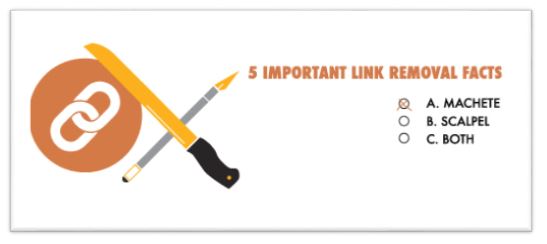Penguin 2.0 launched May 22nd, causing many sites to lose vital rankings, visibility, and traffic. This will without a doubt lead to yet another wave of link removal projects, which have been prevalent since Penguin 1.0.
Before diving into your backlink portfolio and attempting a Penguin recovery, here are 5 important link removal facts of which you should be aware.
1) Matt Cutts recently stated that link removal/disavow needs to be done with a “machete”, not a “scalpel” or “fine toothed comb”.
Cutts is fairly direct and straightforward. When a site is hit by Penguin there’s no sugar-coating it. Anything under suspicion needs to be removed if there’s to be hope of forward progress. His actual statement:
“Hmm. One common issue we see with disavow requests is people going through with a fine-toothed comb when they really need to do something more like a machete on the bad backlinks. For example, often it would help to use the “domain:” operator to disavow all bad backlinks from an entire domain rather than trying to use a scalpel to pick out the individual bad links. That’s one reason why we sometimes see it take a while to clean up those old, not-very-good links.”
Personally I can attest to this. Anyone who has spent time working on link removal, disavow, and reconsideration requests knows that Google’s not going to reward half efforts. There needs to be considerable work done, and a true mending of ways. Even a hint of spam will receive nothing more than a vague “At this time…”
2) There are no guarantees with Google
The first mantra of every SEO’s life should be ‘There are no guarantees with Google’. Before you launch a project, especially link removal, it’s important to stare this statement in the face. Think about it, understand it, and truly accept it.
We’ve had successful link removal campaigns, and we’ve seen recovery from both manual actions and algorithmic penalties. Given enough time, energy, and resources I have no doubt that virtually all recovery campaigns are possible. But, at the end of the day, there are no guarantees with Google.
3) Link Removal isn’t a small undertaking
Link removal is an exhausting task. To meet Google’s standards there are basically four steps to any link removal campaign:
A) Backlink portfolio analysis
Here you’ll be taking a complete analysis of your backlink portfolio using Open Site Explorer, Majestic, or Ahrefs. These can be quite large, potentially with tens of thousands of links or more, and need to be properly categorized.
Again, it’s important to ensure you’re not skimming the worst off the top. You’ll have to dive deep and ensure you’re getting as close to every offender as possible. Specifically:
- Paid links
- Link directories
- Irrelevant links
- Bad link neighborhoods
- Site-wide links on low quality sites
- Spammy blog comments
- Article directories
- Link exchanges
- Etc. etc.
Basically, any link you wouldn’t want Google to take a look at, or you’d have to explain with a conditional statement (that link is actually good because…) get rid of it.
B) Find contact information
You’ll need a way to contact all these sites in order to request to have the link removed – a very important part of the link removal process. Google will potentially ignore any disavowed links if there’s been no effort to have the link removed.
C) Outreach
Such a simple word for an exhausting process. Here, you’ll be contacting every site which you wish to have your link removed from. Which typically involves thousands of sites, depending upon the project.
It’s important to note that contacting them all once isn’t enough. You should contact all the sites at least three times, over the course of a month, in order to prove you’ve made every possible effort.
D) Disavow
You’ll never be able to have every spammy, low quality, irrelevant link removed. There will be sites that are abandoned, sites with no contact information, webmasters that refuse or ask for money, etc. etc.
Once again, make every effort to have the link removed. Once you’ve had as many links as possible removed, go ahead and disavow the rest, including notes as necessary.
E) Rinse and repeat
The hidden step, you’ll often have to rinse and repeat the whole process depending upon Google’s response. Once again, think machete, not scalpel.
4) New links are vital
Link building is generally overlooked, or put on pause, during a link removal campaign. And, while it logically it makes sense to focus all of your energy into link removal, it’s actually better and more effective to build quality links in conjunction to link removal.
This is true for a variety of reasons.
First of all, building quality links signals Google that you’ve changed your ways, mended your tune, and changed your song. These newly built, high authority links will be a point of proof that you’re moving in a new, better direction, which is very important when wrangling with Google.
Secondly, these new links will help lessen the blow of your current link removal. You should be removing a large amount of links from your backlink portfolio. And, no matter how careful you are (you shouldn’t be overly cautious) you’ll be removing links that were passing value. Having new links, of higher quality, should ensure a quick recovery from any dip you see as you remove these links.
5) Link removal is extremely difficult without tools
Tools are absolutely vital to a successful, effective & efficient link removal campaign. Often these projects have hundreds of hours invested into them, and any tool that can help provide an edge is important.
At the bare minimum, you’ll need help from a tool that can run a backlink analysis on your site. Some of the top rated:
- http://www.opensiteexplorer.org/ – from Moz (formerly SEOmoz).
- http://www.majesticseo.com/ – Majestic SEO
- https://ahrefs.com/index.php – Ahrefs, a clever play on the html tag
- http://raventools.com/tools/ – Raven tools
- http://www.link-assistant.com/seo-spyglass/ – SEO Spyglass
Going beyond that, there’s tools specifically developed to help ease the pain of link removal. Some of the top rated:
- Remove’em – A very comprehensive tool, also the most expensive. Helps keep track of the project and emails, as well as suspicious link discovery.
- rmoov – Helps identify contact information, create and manage outreach, complete with reminders.
- SEO Gadget – Automatically rates whether the link is ‘safe or not’. Can do 200 at a time, and will help find contact information as well.
No matter which tools you use, make sure you’re documenting your work. Documentation, documentation, documentation! Not only will it keep the project flowing smoothly and efficiently, but Google’s unlikely to revoke manual actions without proof of effort and change.
Here’s a video from Cutts himself which discusses the unnatural link detection warning as well as a few changes Google’s currently working on:
These 5 link building removal facts will hopefully prove useful as webmasters gear up for lengthy link removal projects, especially since the release of Penguin 2.0. I wish everyone the best moving forward and a speedy recovery.
If you have any questions, comments, or insights, please leave them in the comments below.





